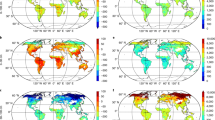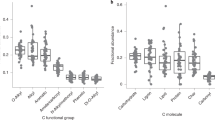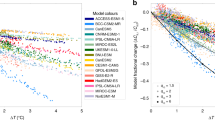Abstract
The Arctic is expected to shift from a sink to a source of atmospheric CO2 this century due to climate-induced increases in soil carbon mineralization1. The magnitude of this effect remains uncertain, largely because temperature sensitivities of organic matter decomposition2,3 and the distribution of these temperature sensitivities across soil carbon pools4 are not well understood. Here, a new analytical method with natural abundance radiocarbon was used to evaluate temperature sensitivities across soil carbon pools. With soils from Utqiaġvik (formerly Barrow), Alaska, an incubation experiment was used to evaluate soil carbon age and decomposability, disentangle the effects of temperature and substrate depletion on carbon mineralization, and compare temperature sensitivities of fast-cycling and slow-cycling carbon. Old, historically stable carbon was shown to be vulnerable to decomposition under warming. Using radiocarbon to differentiate between slow-cycling and fast-cycling carbon, temperature sensitivity was found to be invariant among pools, with a Q10 of ~2 irrespective of native decomposition rate. These findings suggest that mechanisms other than chemical recalcitrance mediate the effect of warming on soil carbon mineralization.
This is a preview of subscription content, access via your institution
Access options
Access Nature and 54 other Nature Portfolio journals
Get Nature+, our best-value online-access subscription
$29.99 / 30 days
cancel any time
Subscribe to this journal
Receive 12 print issues and online access
$209.00 per year
only $17.42 per issue
Buy this article
- Purchase on Springer Link
- Instant access to full article PDF
Prices may be subject to local taxes which are calculated during checkout



Similar content being viewed by others
Data availability
All data generated and analysed in this study are archived in the Next-Generation Ecosystem Experiments (NGEE-Arctic) data repository49 and can be accessed at https://doi.org/10.5440/1418852.
References
Koven, C. D. et al. Permafrost carbon-climate feedbacks accelerate global warming. Proc. Natl Acad. Sci. USA 108, 14769–14774 (2011).
Davidson, E. A. & Janssens, I. A. Temperature sensitivity of soil carbon decomposition and feedbacks to climate change. Nature 440, 165–173 (2006).
Koven, C. D., Lawrence, D. M. & Riley, W. J. Permafrost carbon−climate feedback is sensitive to deep soil carbon decomposability but not deep soil nitrogen dynamics. Proc. Natl Acad. Sci. USA 112, 3752–3757 (2015).
Knorr, W., Prentice, I. C., House, J. I. & Holland, E. A. Long-term sensitivity of soil carbon turnover to warming. Nature 433, 298–301 (2005).
Hugelius, G. et al. Estimated stocks of circumpolar permafrost carbon with quantified uncertainty ranges and identified data gaps. Biogeosciences 11, 6573–6593 (2014).
Schuur, Ea. G. et al. Climate change and the permafrost carbon feedback. Nature 520, 171–179 (2015).
Jorgenson, M. T., Shur, Y. L. & Pullman, E. R. Abrupt increase in permafrost degradation in Arctic Alaska. Geophys. Res. Lett. 33, L02503 (2006).
Osterkamp, T. E. & Romanovsky, V. E. Evidence for warming and thawing of discontinuous permafrost in Alaska. Permafr. Periglac. Process. 10, 17–37 (1999).
Schuur, E. A. et al. The effect of permafrost thaw on old carbon release and net carbon exchange from tundra. Nature 459, 556–559 (2009).
Hicks Pries, C. E., Schuur, E. A. G. & Crummer, K. G. Thawing permafrost increases old soil and autotrophic respiration in tundra: partitioning ecosystem respiration using δC and ∆14C. Glob. Change Biol. 19, 649–661 (2013).
Jones, C. D., Cox, P. & Huntingford, C. Uncertainty in climate–carbon-cycle projections associated with the sensitivity of soil respiration to temperature. Tellus B 55, 642–648 (2003).
Trumbore, S. Age of soil organic matter and soil respiration: radiocarbon constraints on belowground C dynamics. Ecol. Appl. 10, 399–411 (2000).
Lützow, Mv et al. Stabilization of organic matter in temperate soils: mechanisms and their relevance under different soil conditions—a review. Eur. J. Soil Sci. 57, 426–445 (2006).
Conant, R. T. et al. Temperature and soil organic matter decomposition rates – synthesis of current knowledge and a way forward. Glob. Change Biol. 17, 3392–3404 (2011).
Hartley, I. P. & Ineson, P. Substrate quality and the temperature sensitivity of soil organic matter decomposition. Soil Biol. Biochem. 40, 1567–1574 (2008).
Craine, J. M., Fierer, N. & McLauchlan, K. K. Widespread coupling between the rate and temperature sensitivity of organic matter decay. Nat. Geosci. 3, 854–857 (2010).
Feng, X. & Simpson, M. J. Temperature responses of individual soil organic matter components. J. Geophys. Res. Biogeosci. 113, G03036 (2008).
Townsend, A. R., Vitousek, P. M., Desmarais, D. J. & Tharpe, A. Soil carbon pool structure and temperature sensitivity inferred using CO2 and 13CO2 incubation fluxes from five Hawaiian soils. Biogeochemistry 38, 1–17 (1997).
Fang, C., Smith, P., Moncrieff, J. B. & Smith, J. U. Similar response of labile and resistant soil organic matter pools to changes in temperature. Nature 433, 57–59 (2005).
Gillabel, J., Cebrian-Lopez, B., Six, J. & Merckx, R. Experimental evidence for the attenuating effect of SOM protection on temperature sensitivity of SOM decomposition. Glob. Change Biol. 16, 2789–2798 (2010).
Dioumaeva, I. et al. Decomposition of peat from upland boreal forest: temperature dependence and sources of respired carbon. J. Geophys. Res. Atmos. 107, 8222 (2002).
Kleber, M. et al. Old and stable soil organic matter is not necessarily chemically recalcitrant: implications for modeling concepts and temperature sensitivity. Glob. Change Biol. 17, 1097–1107 (2011).
Reichstein, M. et al. Temperature sensitivity of decomposition in relation to soil organic matter pools: critique and outlook. Biogeosciences 2, 317–321 (2005).
Bradford, M. A. et al. Thermal adaptation of soil microbial respiration to elevated temperature. Ecol. Lett. 11, 1316–1327 (2008).
Tang, J. & Riley, W. J. Weaker soil carbon–climate feedbacks resulting from microbial and abiotic interactions. Nat. Clim. Change 5, 56–60 (2015).
Lupascu, M., Welker, J. M., Xu, X. & Czimczik, C. I. Rates and radiocarbon content of summer ecosystem respiration in response to long-term deeper snow in the High Arctic of NW Greenland. J. Geophys. Res. Biogeosci. 119, 2013JG002494 (2014).
Vaughn, L. J. S. & Torn, M. S. Radiocarbon measurements of ecosystem respiration and soil pore-space CO2 in Utqiaġvik (Barrow), Alaska. Earth Syst. Sci. Data. 10, 1943–1957 (2018).
Friedlingstein, P. et al. Climate–carbon cycle feedback analysis: results from the C4MIP model intercomparison. J. Clim. 19, 3337–3353 (2006).
German, D. P., Marcelo, K. R. B., Stone, M. M. & Allison, S. D. The Michaelis–Menten kinetics of soil extracellular enzymes in response to temperature: a cross-latitudinal study. Glob. Change Biol. 18, 1468–1479 (2012).
Min, K., Lehmeier, C. A., Ballantyne, F., Tatarko, A. & Billings, S. A. Differential effects of pH on temperature sensitivity of organic carbon and nitrogen decay. Soil Biol. Biochem. 76, 193–200 (2014).
Bockheim, J. G., Everett, L. R., Hinkel, K. M., Nelson, F. E. & Brown, J. Soil organic carbon storage and distribution in Arctic tundra, Barrow, Alaska. Soil Sci. Soc. Am. J. 63, 934–940 (1999).
Billings, W. D. & Peterson, K. M. Vegetational change and ice-wedge polygons through the thaw-lake cycle in Arctic Alaska. Arct. Alp. Res. 4, 413–432 (1980).
Brown, J, Miller, P. C, Tieszen, L. L. & Bunnell, F. An Arctic Ecosystem: The Coastal Tundra at Barrow, Alaska (Hutchinson and Ross, 1980).
Wainwright, H. M. et al. Identifying multiscale zonation and assessing the relative importance of polygon geomorphology on carbon fluxes in an Arctic tundra ecosystem. J. Geophys. Res. Biogeosci. 120, 788–808 (2015).
Sloan, V. L. et al. Plant Community Composition and Vegetation Height, Barrow, Alaska, Ver. 1 (Carbon Dioxide Information Analysis Center, 2014).
Newman, B. D. et al. Microtopographic and depth controls on active layer chemistry in Arctic polygonal ground. Geophys. Res. Lett. 42, 1808–1817 (2015).
Graven, H. D., Guilderson, T. P. & Keeling, R. F. Methods for high-precision14C AMS measurement of atmospheric CO2 at LLNL. Radiocarbon 49, 349–356 (2007).
Stuiver, M. & Polach, H. A. Discussion reporting of 14C data. Radiocarbon 19, 355–363 (1977).
Torn, M., Swanston, C., Castanha, C. & Trumbore, S. in Biophysico-Chemical Processes Involving Natural Nonliving Organic Matter in Environmental Systems (eds Sinesi, N. et al.) 219–272 (John Wiley, 2009).
Reimer, P. J. et al. IntCal13 and Marine13 Radiocarbon Age Calibration Curves 0–50,000 Years cal BP. Radiocarbon 55, 1869–1887 (2013).
Nydal, R. & Lövseth, K. Carbon-14 Measurements in Atmospheric CO 2 from Northern and Southern Hemisphere Sites, 1962–1993 (Oak Ridge National Lab., Oak Ridge Inst. for Science and Education, 1996).
Graven, H. D., Guilderson, T. P. & Keeling, R. F. Observations of radiocarbon in CO2 at seven global sampling sites in the Scripps flask network: analysis of spatial gradients and seasonal cycles. J. Geophys. Res. Atmos. 117, D02303 (2012).
Loya, W. M. et al. Pulse-labeling studies of carbon cycling in arctic tundra ecosystems: Contribution of photosynthates to soil organic matter. Glob. Biogeochem. Cycles 16, 1101 (2002).
Dennis, J. G. Distribution patterns of belowground standing crop in arctic tundra at barrow, Alaska. Arct. Alp. Res. 9, 113 (1977).
Billings, W. D., Peterson, K. M. & Shaver, G. R. in Vegetation and Production Ecology of an Alaskan Arctic Tundra (ed. Tieszen, L. L.) 415–434 (Springer New York, 1978).
Sierra, C. A., Müller, M., Metzler, H., Manzoni, S. & Trumbore, S. E. The muddle of ages, turnover, transit, and residence times in the carbon cycle. Glob. Change Biol. 23, 1763–1773 (2017).
Bates, D., Maechler, M., Bolker, B. M. & Walker, S. lme4: Linear mixed-effects models using Eigen and S4. R package version 1.1-7. (2014).
Kuznetsova, A., Brockhoff, P. B. & Christensen, R. H. B. lmerTest: Tests for random and fixed effects for linear mixed effect models (lmer objects of lme4 package). R package version 2.0-11. (2014).
Vaughn, L. J. S. & Torn, M. S. Radiocarbon in CO2 and Soil Organic Matter from Laboratory Incubations, Barrow, Alaska, 2012. (Next Generation Ecosystem Experiments Arctic Data Collection, Oak Ridge National Laboratory, U.S. Department of Energy, 2018).
Acknowledgements
This research was conducted through the Next-Generation Ecosystem Experiments (NGEE-Arctic) project, which is supported by the Office of Biological and Environmental Research in the US Department of Energy Office of Science.
Author information
Authors and Affiliations
Contributions
L.J.S.V. and M.S.T. designed the soil collection and incubation procedure, L.J.S.V. collected data and designed the analysis with guidance from M.S.T., and L.J.S.V. prepared the manuscript with contributions from M.S.T.
Corresponding authors
Ethics declarations
Competing interests
The authors declare no competing interests.
Additional information
Publisher’s note: Springer Nature remains neutral with regard to jurisdictional claims in published maps and institutional affiliations.
Supplementary information
Supplementary Information
Supplementary Figures 1–12 and Supplementary Tables 1–5.
Rights and permissions
About this article
Cite this article
Vaughn, L.J.S., Torn, M.S. 14C evidence that millennial and fast-cycling soil carbon are equally sensitive to warming. Nat. Clim. Chang. 9, 467–471 (2019). https://doi.org/10.1038/s41558-019-0468-y
Received:
Accepted:
Published:
Issue Date:
DOI: https://doi.org/10.1038/s41558-019-0468-y
This article is cited by
-
Global soil profiles indicate depth-dependent soil carbon losses under a warmer climate
Nature Communications (2022)
-
Responses of soil microbial carbon use efficiency to warming: Review and prospects
Soil Ecology Letters (2022)
-
Impacts of nutrient addition on soil carbon and nitrogen stoichiometry and stability in globally-distributed grasslands
Biogeochemistry (2022)
-
Effects of mixing biochar on soil N2O, CO2, and CH4 emissions after prescribed fire in alpine meadows of Wugong Mountain, China
Journal of Soils and Sediments (2020)
-
Old Arctic carbon stability
Nature Climate Change (2019)



